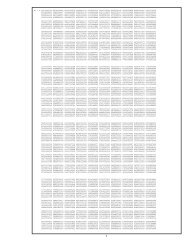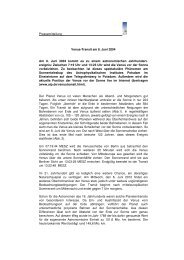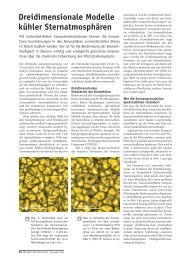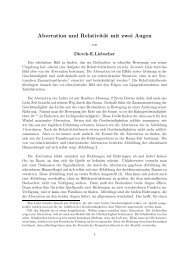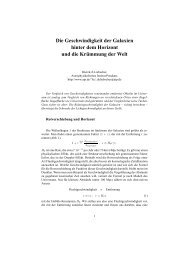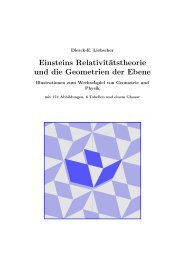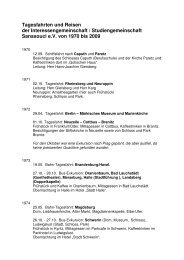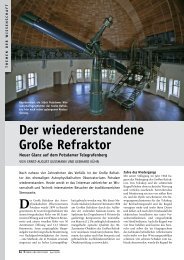14.1 Moments of a Distribution: Mean, Variance, Skewness ... - AIP
14.1 Moments of a Distribution: Mean, Variance, Skewness ... - AIP
14.1 Moments of a Distribution: Mean, Variance, Skewness ... - AIP
Create successful ePaper yourself
Turn your PDF publications into a flip-book with our unique Google optimized e-Paper software.
610 Chapter 14. Statistical Description <strong>of</strong> Data<br />
In the other category, model-dependent statistics, we lump the whole subject <strong>of</strong><br />
fitting data to a theory, parameter estimation, least-squares fits, and so on. Those<br />
subjects are introduced in Chapter 15.<br />
Section <strong>14.1</strong> deals with so-called measures <strong>of</strong> central tendency, the moments <strong>of</strong><br />
a distribution, the median and mode. In §14.2 we learn to test whether different data<br />
sets are drawn from distributions with different values <strong>of</strong> these measures <strong>of</strong> central<br />
tendency. This leads naturally, in §14.3, to the more general question <strong>of</strong> whether two<br />
distributions can be shown to be (significantly) different.<br />
In §14.4–§14.7, we deal with measures <strong>of</strong> association for two distributions.<br />
We want to determine whether two variables are “correlated” or “dependent” on<br />
one another. If they are, we want to characterize the degree <strong>of</strong> correlation in<br />
some simple ways. The distinction between parametric and nonparametric (rank)<br />
methods is emphasized.<br />
Section 14.8 introduces the concept <strong>of</strong> data smoothing, and discusses the<br />
particular case <strong>of</strong> Savitzky-Golay smoothing filters.<br />
This chapter draws mathematically on the material on special functions that<br />
was presented in Chapter 6, especially §6.1–§6.4. You may wish, at this point,<br />
to review those sections.<br />
CITED REFERENCES AND FURTHER READING:<br />
Bevington, P.R. 1969, Data Reduction and Error Analysis for the Physical Sciences (New York:<br />
McGraw-Hill).<br />
Stuart, A., and Ord, J.K. 1987, Kendall’s Advanced Theory <strong>of</strong> Statistics, 5th ed. (London: Griffin<br />
and Co.) [previous eds. published as Kendall, M., and Stuart, A., The Advanced Theory<br />
<strong>of</strong> Statistics].<br />
Norusis, M.J. 1982, SPSS Introductory Guide: Basic Statistics and Operations; and 1985, SPSS-<br />
X Advanced Statistics Guide (New York: McGraw-Hill).<br />
Dunn, O.J., and Clark, V.A. 1974, Applied Statistics: Analysis <strong>of</strong> <strong>Variance</strong> and Regression (New<br />
York: Wiley).<br />
<strong>14.1</strong> <strong>Moments</strong> <strong>of</strong> a <strong>Distribution</strong>: <strong>Mean</strong>,<br />
<strong>Variance</strong>, <strong>Skewness</strong>, and So Forth<br />
When a set <strong>of</strong> values has a sufficiently strong central tendency, that is, a tendency<br />
to cluster around some particular value, then it may be useful to characterize the<br />
set by a few numbers that are related to its moments, the sums <strong>of</strong> integer powers<br />
<strong>of</strong> the values.<br />
Best known is the mean <strong>of</strong> the values x 1 ,...,x N ,<br />
x= 1 N<br />
N∑<br />
x j (<strong>14.1</strong>.1)<br />
j=1<br />
Sample page from NUMERICAL RECIPES IN C: THE ART OF SCIENTIFIC COMPUTING (ISBN 0-521-43108-5)<br />
Copyright (C) 1988-1992 by Cambridge University Press.Programs Copyright (C) 1988-1992 by Numerical Recipes S<strong>of</strong>tware.<br />
Permission is granted for internet users to make one paper copy for their own personal use. Further reproduction, or any copying <strong>of</strong> machinereadable<br />
files (including this one) to any servercomputer, is strictly prohibited. To order Numerical Recipes books,diskettes, or CDROMs<br />
visit website http://www.nr.com or call 1-800-872-7423 (North America only),or send email to trade@cup.cam.ac.uk (outside North America).<br />
which estimates the value around which central clustering occurs. Note the use <strong>of</strong><br />
an overbar to denote the mean; angle brackets are an equally common notation, e.g.,<br />
〈x〉. You should be aware that the mean is not the only available estimator <strong>of</strong> this
<strong>14.1</strong> <strong>Moments</strong> <strong>of</strong> a <strong>Distribution</strong>: <strong>Mean</strong>, <strong>Variance</strong>, <strong>Skewness</strong> 611<br />
quantity, nor is it necessarily the best one. For values drawn from a probability<br />
distribution with very broad “tails,” the mean may converge poorly, or not at all, as<br />
the number <strong>of</strong> sampled points is increased. Alternative estimators, the median and<br />
the mode, are mentioned at the end <strong>of</strong> this section.<br />
Having characterized a distribution’s central value, one conventionally next<br />
characterizes its “width” or “variability” around that value. Here again, more than<br />
one measure is available. Most common is the variance,<br />
Var(x 1 ...x N )= 1<br />
N−1<br />
or its square root, the standard deviation,<br />
N∑<br />
(x j − x) 2 (<strong>14.1</strong>.2)<br />
j=1<br />
σ(x 1 ...x N )= √ Var(x 1 ...x N ) (<strong>14.1</strong>.3)<br />
Equation (<strong>14.1</strong>.2) estimates the mean squared deviation <strong>of</strong> x from its mean value.<br />
There is a long story about why the denominator <strong>of</strong> (<strong>14.1</strong>.2) is N − 1 instead <strong>of</strong><br />
N. If you have never heard that story, you may consult any good statistics text.<br />
Here we will be content to note that the N − 1 should be changed to N if you<br />
are ever in the situation <strong>of</strong> measuring the variance <strong>of</strong> a distribution whose mean<br />
x is known apriorirather than being estimated from the data. (We might also<br />
comment that if the difference between N and N − 1 ever matters to you, then you<br />
are probably up to no good anyway — e.g., trying to substantiate a questionable<br />
hypothesis with marginal data.)<br />
As the mean depends on the first moment <strong>of</strong> the data, so do the variance and<br />
standard deviation depend on the second moment. It is not uncommon, in real<br />
life, to be dealing with a distribution whose second moment does not exist (i.e., is<br />
infinite). In this case, the variance or standard deviation is useless as a measure<br />
<strong>of</strong> the data’s width around its central value: The values obtained from equations<br />
(<strong>14.1</strong>.2) or (<strong>14.1</strong>.3) will not converge with increased numbers <strong>of</strong> points, nor show<br />
any consistency from data set to data set drawn from the same distribution. This can<br />
occur even when the width <strong>of</strong> the peak looks, by eye, perfectly finite. A more robust<br />
estimator <strong>of</strong> the width is the average deviation or mean absolute deviation,definedby<br />
ADev(x 1 ...x N )= 1 N<br />
N∑<br />
|x j − x| (<strong>14.1</strong>.4)<br />
One <strong>of</strong>ten substitutes the sample median x med for x in equation (<strong>14.1</strong>.4). For any<br />
fixed sample, the median in fact minimizes the mean absolute deviation.<br />
Statisticians have historically sniffed at the use <strong>of</strong> (<strong>14.1</strong>.4) instead <strong>of</strong> (<strong>14.1</strong>.2),<br />
since the absolute value brackets in (<strong>14.1</strong>.4) are “nonanalytic” and make theoremproving<br />
difficult. In recent years, however, the fashion has changed, and the subject<br />
<strong>of</strong> robust estimation (meaning, estimation for broad distributions with significant<br />
numbers <strong>of</strong> “outlier” points) has become a popular and important one. Higher<br />
moments, or statistics involving higher powers <strong>of</strong> the input data, are almost always<br />
less robust than lower moments or statistics that involve only linear sums or (the<br />
lowest moment <strong>of</strong> all) counting.<br />
j=1<br />
Sample page from NUMERICAL RECIPES IN C: THE ART OF SCIENTIFIC COMPUTING (ISBN 0-521-43108-5)<br />
Copyright (C) 1988-1992 by Cambridge University Press.Programs Copyright (C) 1988-1992 by Numerical Recipes S<strong>of</strong>tware.<br />
Permission is granted for internet users to make one paper copy for their own personal use. Further reproduction, or any copying <strong>of</strong> machinereadable<br />
files (including this one) to any servercomputer, is strictly prohibited. To order Numerical Recipes books,diskettes, or CDROMs<br />
visit website http://www.nr.com or call 1-800-872-7423 (North America only),or send email to trade@cup.cam.ac.uk (outside North America).
612 Chapter 14. Statistical Description <strong>of</strong> Data<br />
(a)<br />
negative<br />
<strong>Skewness</strong><br />
positive<br />
negative<br />
(platykurtic)<br />
<br />
<br />
(b)<br />
Kurtosis<br />
positive<br />
(leptokurtic)<br />
Figure <strong>14.1</strong>.1. <strong>Distribution</strong>s whose third and fourth moments are significantly different from a normal<br />
(Gaussian) distribution. (a) <strong>Skewness</strong> or third moment. (b) Kurtosis or fourth moment.<br />
That being the case, the skewness or third moment, andthekurtosis or fourth<br />
moment should be used with caution or, better yet, not at all.<br />
The skewness characterizes the degree <strong>of</strong> asymmetry <strong>of</strong> a distribution around its<br />
mean. While the mean, standard deviation, and average deviation are dimensional<br />
quantities, that is, have the same units as the measured quantities x j , the skewness<br />
is conventionally defined in such a way as to make it nondimensional. It is a pure<br />
number that characterizes only the shape <strong>of</strong> the distribution. The usual definition is<br />
Skew(x 1 ...x N )= 1 N<br />
N∑<br />
[ ] 3 xj − x<br />
(<strong>14.1</strong>.5)<br />
where σ = σ(x 1 ...x N )is the distribution’s standard deviation (<strong>14.1</strong>.3). A positive<br />
value <strong>of</strong> skewness signifies a distribution with an asymmetric tail extending out<br />
towards more positive x; a negative value signifies a distribution whose tail extends<br />
out towards more negative x (see Figure <strong>14.1</strong>.1).<br />
Of course, any set <strong>of</strong> N measured values is likely to give a nonzero value<br />
for (<strong>14.1</strong>.5), even if the underlying distribution is in fact symmetrical (has zero<br />
skewness). For (<strong>14.1</strong>.5) to be meaningful, we need to have some idea <strong>of</strong> its<br />
standard deviation as an estimator <strong>of</strong> the skewness <strong>of</strong> the underlying distribution.<br />
Unfortunately, that depends on the shape <strong>of</strong> the underlying distribution, and rather<br />
critically on its tails! For the idealized case <strong>of</strong> a normal (Gaussian) distribution, the<br />
standard deviation<strong>of</strong> (<strong>14.1</strong>.5) is approximately √ 15/N. In real life it is good practice<br />
to believe in skewnesses only when they are several or many times as large as this.<br />
The kurtosis is also a nondimensional quantity. It measures the relative<br />
peakedness or flatness <strong>of</strong> a distribution. Relative to what? A normal distribution,<br />
what else! A distribution with positive kurtosis is termed leptokurtic; the outline<br />
<strong>of</strong> the Matterhorn is an example. A distribution with negative kurtosis is termed<br />
platykurtic; the outline <strong>of</strong> a loaf <strong>of</strong> bread is an example. (See Figure <strong>14.1</strong>.1.) And,<br />
as you no doubt expect, an in-between distribution is termed mesokurtic.<br />
The conventional definition <strong>of</strong> the kurtosis is<br />
⎧<br />
⎫<br />
⎨<br />
1<br />
N∑<br />
[ ] 4 xj − x ⎬<br />
Kurt(x 1 ...x N )=<br />
⎩N<br />
σ ⎭ − 3 (<strong>14.1</strong>.6)<br />
j=1<br />
j=1<br />
σ<br />
Sample page from NUMERICAL RECIPES IN C: THE ART OF SCIENTIFIC COMPUTING (ISBN 0-521-43108-5)<br />
Copyright (C) 1988-1992 by Cambridge University Press.Programs Copyright (C) 1988-1992 by Numerical Recipes S<strong>of</strong>tware.<br />
Permission is granted for internet users to make one paper copy for their own personal use. Further reproduction, or any copying <strong>of</strong> machinereadable<br />
files (including this one) to any servercomputer, is strictly prohibited. To order Numerical Recipes books,diskettes, or CDROMs<br />
visit website http://www.nr.com or call 1-800-872-7423 (North America only),or send email to trade@cup.cam.ac.uk (outside North America).<br />
where the −3 term makes the value zero for a normal distribution.
<strong>14.1</strong> <strong>Moments</strong> <strong>of</strong> a <strong>Distribution</strong>: <strong>Mean</strong>, <strong>Variance</strong>, <strong>Skewness</strong> 613<br />
The standard deviation <strong>of</strong> (<strong>14.1</strong>.6) as an estimator <strong>of</strong> the kurtosis <strong>of</strong> an<br />
underlying normal distribution is √ 96/N. However, the kurtosis depends on such<br />
a high moment that there are many real-life distributions for which the standard<br />
deviation <strong>of</strong> (<strong>14.1</strong>.6) as an estimator is effectively infinite.<br />
Calculation <strong>of</strong> the quantities defined in this section is perfectly straightforward.<br />
Many textbooks use the binomial theorem to expand out the definitions into sums<br />
<strong>of</strong> various powers <strong>of</strong> the data, e.g., the familiar<br />
⎡⎛<br />
⎞ ⎤<br />
Var(x 1 ...x N )= 1 N∑<br />
⎣⎝<br />
x 2 ⎠<br />
j − Nx 2 ⎦ ≈ x<br />
N−1<br />
2 − x 2 (<strong>14.1</strong>.7)<br />
j=1<br />
but this can magnify the round<strong>of</strong>f error by a large factor and is generally unjustifiable<br />
in terms <strong>of</strong> computing speed. A clever way to minimize round<strong>of</strong>f error, especially<br />
for large samples, is to use the corrected two-pass algorithm [1]: First calculate x,<br />
then calculate Var(x 1 ...x N ) by<br />
⎧<br />
⎡<br />
⎤<br />
Var(x 1 ...x N )= 1 ⎪⎨<br />
⎫ N∑<br />
(x j − x) 2 − 1 ⎪ N∑ ⎬<br />
⎣ (x j − x) ⎦2<br />
(<strong>14.1</strong>.8)<br />
N−1⎪⎩<br />
N<br />
⎪ ⎭<br />
j=1<br />
The second sum would be zero if x were exact, but otherwise it does a good job <strong>of</strong><br />
correcting the round<strong>of</strong>f error in the first term.<br />
#include <br />
void moment(float data[], int n, float *ave, float *adev, float *sdev,<br />
float *var, float *skew, float *curt)<br />
Given an array <strong>of</strong> data[1..n], this routine returns its mean ave, average deviation adev,<br />
standard deviation sdev, variancevar, skewnessskew, andkurtosiscurt.<br />
{<br />
void nrerror(char error_text[]);<br />
int j;<br />
float ep=0.0,s,p;<br />
}<br />
j=1<br />
if (n
614 Chapter 14. Statistical Description <strong>of</strong> Data<br />
Semi-Invariants<br />
The mean and variance <strong>of</strong> independent random variables are additive: If x and y are<br />
drawn independently from two, possibly different, probability distributions, then<br />
(x + y) =x+y Var(x + y)=Var(x)+Var(x) (<strong>14.1</strong>.9)<br />
Higher moments are not, in general, additive. However, certain combinations <strong>of</strong> them,<br />
called semi-invariants, are in fact additive. If the centered moments <strong>of</strong> a distribution are<br />
denoted M k,<br />
〈<br />
M k ≡ (x i − x) k〉 (<strong>14.1</strong>.10)<br />
so that, e.g., M 2 = Var(x), then the first few semi-invariants, denoted I k are given by<br />
I 2 = M 2 I 3 = M 3 I 4 = M 4 − 3M2<br />
2 (<strong>14.1</strong>.11)<br />
I 5 = M 5 − 10M 2M 3 I 6 = M 6 − 15M 2M 4 − 10M3 2 +30M2<br />
3<br />
Notice that the skewness and kurtosis, equations (<strong>14.1</strong>.5) and (<strong>14.1</strong>.6) are simple powers<br />
<strong>of</strong> the semi-invariants,<br />
Skew(x) =I 3/I 3/2<br />
2 Kurt(x) =I 4/I 2 2 (<strong>14.1</strong>.12)<br />
A Gaussian distribution has all its semi-invariants higher than I 2 equal to zero. A Poisson<br />
distribution has all <strong>of</strong> its semi-invariants equal to its mean. For more details, see [2].<br />
Median and Mode<br />
The median <strong>of</strong> a probability distribution function p(x) is the value x med for<br />
which larger and smaller values <strong>of</strong> x are equally probable:<br />
∫ xmed<br />
−∞<br />
p(x) dx = 1 2 = ∫ ∞<br />
x med<br />
p(x) dx (<strong>14.1</strong>.13)<br />
The median <strong>of</strong> a distribution is estimated from a sample <strong>of</strong> values x 1 ,...,<br />
x N by finding that value x i which has equal numbers <strong>of</strong> values above it and below<br />
it. Of course, this is not possible when N is even. In that case it is conventional<br />
to estimate the median as the mean <strong>of</strong> the unique two central values. If the values<br />
x j j =1,...,N are sorted into ascending (or, for that matter, descending) order,<br />
then the formula for the median is<br />
{ x(N+1)/2 , N odd<br />
x med =<br />
1<br />
2 (x N/2 + x (N/2)+1 ), N even<br />
(<strong>14.1</strong>.14)<br />
If a distribution has a strong central tendency, so that most <strong>of</strong> its area is under<br />
a single peak, then the median is an estimator <strong>of</strong> the central value. It is a more<br />
robust estimator than the mean is: The median fails as an estimator only if the area<br />
in the tails is large, while the mean fails if the first moment <strong>of</strong> the tails is large;<br />
it is easy to construct examples where the first moment <strong>of</strong> the tails is large even<br />
though their area is negligible.<br />
To find the median <strong>of</strong> a set <strong>of</strong> values, one can proceed by sorting the set and<br />
then applying (<strong>14.1</strong>.14). This is a process <strong>of</strong> order N log N. You might rightly think<br />
Sample page from NUMERICAL RECIPES IN C: THE ART OF SCIENTIFIC COMPUTING (ISBN 0-521-43108-5)<br />
Copyright (C) 1988-1992 by Cambridge University Press.Programs Copyright (C) 1988-1992 by Numerical Recipes S<strong>of</strong>tware.<br />
Permission is granted for internet users to make one paper copy for their own personal use. Further reproduction, or any copying <strong>of</strong> machinereadable<br />
files (including this one) to any servercomputer, is strictly prohibited. To order Numerical Recipes books,diskettes, or CDROMs<br />
visit website http://www.nr.com or call 1-800-872-7423 (North America only),or send email to trade@cup.cam.ac.uk (outside North America).
14.2 Do Two <strong>Distribution</strong>s Have the Same <strong>Mean</strong>s or <strong>Variance</strong>s? 615<br />
that this is wasteful, since it yields much more information than just the median<br />
(e.g., the upper and lower quartile points, the deciles, etc.). In fact, we saw in<br />
§8.5 that the element x (N+1)/2 can be located in <strong>of</strong> order N operations. Consult<br />
that section for routines.<br />
The mode <strong>of</strong> a probability distribution function p(x) is the value <strong>of</strong> x where it<br />
takes on a maximum value. The mode is useful primarily when there is a single, sharp<br />
maximum, in which case it estimates the central value. Occasionally, a distribution<br />
will be bimodal, with two relative maxima; then one may wish to know the two<br />
modes individually. Note that, in such cases, the mean and median are not very<br />
useful, since they will give only a “compromise” value between the two peaks.<br />
CITED REFERENCES AND FURTHER READING:<br />
Bevington, P.R. 1969, Data Reduction and Error Analysis for the Physical Sciences (New York:<br />
McGraw-Hill), Chapter 2.<br />
Stuart, A., and Ord, J.K. 1987, Kendall’s Advanced Theory <strong>of</strong> Statistics, 5th ed. (London: Griffin<br />
and Co.) [previous eds. published as Kendall, M., and Stuart, A., The Advanced Theory<br />
<strong>of</strong> Statistics], vol. 1, §10.15<br />
Norusis, M.J. 1982, SPSS Introductory Guide: Basic Statistics and Operations; and 1985, SPSS-<br />
X Advanced Statistics Guide (New York: McGraw-Hill).<br />
Chan, T.F., Golub, G.H., and LeVeque, R.J. 1983, American Statistician, vol. 37, pp. 242–247. [1]<br />
Cramér, H. 1946, Mathematical Methods <strong>of</strong> Statistics (Princeton: Princeton University Press),<br />
§15.10. [2]<br />
14.2 Do Two <strong>Distribution</strong>s Have the Same<br />
<strong>Mean</strong>s or <strong>Variance</strong>s?<br />
Not uncommonly we want to know whether two distributions have the same<br />
mean. For example, a first set <strong>of</strong> measured values may have been gathered before<br />
some event, a second set after it. We want to know whether the event, a “treatment”<br />
or a “change in a control parameter,” made a difference.<br />
Our first thought is to ask “how many standard deviations” one sample mean is<br />
from the other. That number may in fact be a useful thing to know. It does relate to<br />
the strength or “importance” <strong>of</strong> a difference <strong>of</strong> means if that difference is genuine.<br />
However, by itself, it says nothing about whether the difference is genuine, that is,<br />
statistically significant. A difference <strong>of</strong> means can be very small compared to the<br />
standard deviation, and yet very significant, if the number <strong>of</strong> data points is large.<br />
Conversely, a difference may be moderately large but not significant, if the data<br />
are sparse. We will be meeting these distinct concepts <strong>of</strong> strength and significance<br />
several times in the next few sections.<br />
A quantity that measures the significance <strong>of</strong> a difference <strong>of</strong> means is not the<br />
number <strong>of</strong> standard deviations that they are apart, but the number <strong>of</strong> so-called<br />
standard errors that they are apart. The standard error <strong>of</strong> a set <strong>of</strong> values measures<br />
the accuracy with which the sample mean estimates the population (or “true”) mean.<br />
Typically the standard error is equal to the sample’s standard deviation divided by<br />
the square root <strong>of</strong> the number <strong>of</strong> points in the sample.<br />
Sample page from NUMERICAL RECIPES IN C: THE ART OF SCIENTIFIC COMPUTING (ISBN 0-521-43108-5)<br />
Copyright (C) 1988-1992 by Cambridge University Press.Programs Copyright (C) 1988-1992 by Numerical Recipes S<strong>of</strong>tware.<br />
Permission is granted for internet users to make one paper copy for their own personal use. Further reproduction, or any copying <strong>of</strong> machinereadable<br />
files (including this one) to any servercomputer, is strictly prohibited. To order Numerical Recipes books,diskettes, or CDROMs<br />
visit website http://www.nr.com or call 1-800-872-7423 (North America only),or send email to trade@cup.cam.ac.uk (outside North America).



